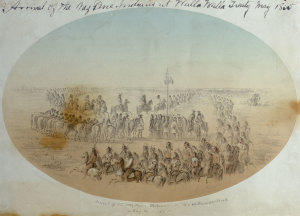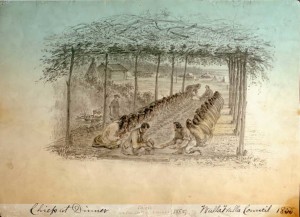Welcome to the Walla Walla Treaty Council of 1855 History Website
Treaty Council of 1855
In 1855 a treaty council was held in the Walla Walla Valley between Governor Isaac Stevens of Washington Territory, Superintendent of Indian Affairs Joel Palmer of Oregon Territory, and many of the upper Columbia and Snake River Indian tribes.
The council opened on May 29, 1855 on the north bank of Mill Creek in what is now the city of Walla Walla, and concluded 13 days later on June 11. Several thousand Indians were present, as well as Stevens’ and Palmer’s supporting staff, a detachment of soldiers, and a number of whites living in the area.
It has been said of this event, “In its general importance and difficulty [it] has never been equaled by any council held with the Indian tribes of the United States.” The council resulted in the signing of three treaties, establishing the Yakama, Nez Perce, and Umatilla Indian Reservations, and the ceding of all remaining tribal lands to the United States.
Location of the Council Grounds
The location of the exact grounds of the Treaty Council of 1855 has been a topic of considerable controversy over the years. What is clear from the reports of Gov. Isaac Stevens and his staff is that it was on the north bank of Mill Creek. Most all students of the question agree in addition that it was somewhere east of the current intersection of First and Main in the city of Walla Walla, though precisely where has not been determined.
Two local monuments refer to the Treaty Council grounds. The oldest is the treaty council stone behind Carnegie Center at Palouse & Alder. The marker there reads, “Near this site May 29 to June 11, 1855 was held the Great Indian Council by Governor Isaac Ingalls Stevens with chiefs of the Nez Perce, Yakima, Cayuse and Walla Walla Indian Tribes of Washington, Oregon and Idaho. Placed 1925 by Narcissa Prentiss Chapter D.A.R., Walla Walla.”
The second monument is the treaty rock at the entrance to the Whitman College amphitheater placed there five years later, which has two inscriptions. The first is by the class of 1930 which donated the rock, and reads in part, “Here were camped from May 24 to June 12, 1855, two thousand Indians of the Nez Perce Tribe, with their famous chief, Hol-Lol-Sote-Tote, Lawyer, attending the Great Council called by Governor Stevens.”
The second inscription on the Whitman treaty rock was added in 1955, and reads, “To commemorate the 100th anniversary of the signing by their forefathers of the treaties with the United States of America near this place on June 9 and 11, 1855, this plaque is presented by the people of the Yakima, Nez Perce, Cayuse, Walla Walla, and Umatilla Indian Tribes. He-Pa-Nak-Ne-Koo Kun-Koo Nu-Nim Pe-Wa-Ynpt. June 11, 1955.”
While the camps of the various participants were spread out over a large area, it appears likely that the main council deliberations took place in the vicinity of the earlier monument behind Carnegie Center.
In support of this view, Whitman College historian W.D. Lyman in his History of Old Walla Walla County (1918) writes: “There seems some difference of opinion as to the exact location of the conference. It has generally been thought that Stevens’ camp was at what is now known as Council Grove Addition, near the residence of ex-Senator Ankeny.”
The name Council Grove was given to the area just southeast of the intersection of Park & Alder Streets in the vicinity of Carnegie Center. Crescent Street, where Senator Ankeny lived, begins at Alder Street just east of that intersection, and from there curves into Birch Street.
Although the current channel of Mill Creek is north of this location, according to Professor Lyman, “It appears from the testimony of old-timers that Mill Creek has changed its course at intervals in these years, and that as a result the exact identification [of the Council grounds] is difficult.
It is possible that in 1855 Mill Creek followed the curve of Crescent Street or was at least parallel to it and then continued down or parallel to Birch, as it did during the flood of 1931, before the construction of the current concrete channel. That would have put this site on the north bank of Mill Creek at the time, consistent with early accounts of its location.
Additional confirmation of this theory is found in the 1876 birds-eye view map of Walla Walla showing large trees lining the south bank of Mill Creek as it approaches Alder before continuing northwest on the bank of the creek in its current channel, as well as continuing southwest to a large grove and open space along Crescent Street, suggesting that the creek previously took this path.
Regarding the Whitman location, Lyman wrote in 1918, “William McBean, a son of the Hudson’s Bay Company agent at Fort Walla Walla during the Cayuse war, who was himself in Stevens’ force as a young boy, told the author nearly thirty years ago that he believed the chief point of the conference was almost exactly on the present site of Whitman College…. It seems plain…that the Indians were camped at various places along two spring branches, College Creek and Tannery Creek.”
Lyman also mentions the view that the council was “near the residence of Mrs. Clara Quinn.” W.W. 2020 research has identified that residence as being at the corner of Colville and Rose, just northeast of the intersection of First & Main, where Fort Walla Walla was established in 1856. The fort is also said by some to have been on the treaty council grounds.
Proceedings at the Treaty Council
A Record of Official Proceedings was kept that sets down word for word the statements in English of Governor Stevens and General Palmer, and the English translations by the interpreters of the statements of each of the Indian leaders who spoke.
These included Peopeomoxmox of the Walla Wallas; for the Cayuse: Young Chief, Five Crows, Stickus, Camaspello, and Howlish-wampum; for the Nez Perce: Looking Glass, Lawyer, Eagle from the Light, Joseph, and Red Wolf, and for the Yakamas: Kamiakin, Owhi, and Skloom—along with several other Indians.
Key excerpts from this official record are available at http://www.wallawallatreatycouncils.blogspot.com/, including these statements:
Gov. Stevens: The Great Father first learned of you from Lewis and Clark. Peopeomoxmox remembers Lewis and Clark; the Lawyer does. The Great Father has been for many years caring for his red children across the mountains. There (pointing East), it has been found that with farms, schools, shops and laws the red men could be protected. Trouble has been made by bad white men. The Great Father desires to make arrangements so you can be protected from these men. We are now in council to see if we can arrange the terms which will carry this into effect.
Eagle from the Light: The time the first white men passed through this country, although the people of this country were blind, it was their heart to be friendly to them. Although they did not know what the White people said to them they answered, yes, as if they were blind. I have been talked to by the French and by the Americans, and one says to me go this way, and the other says go another way, and I am lost between them.
Peopeomoxmox: We have listened to all you have to say, and we desire you should listen when any Indian speaks. It appears that he wants an answer immediately without giving them time to think, that the Indians have had nothing to say so far. We have not seen in a true light the object of your speeches, as if there was a post set between us, as if my heart cried from what you have said. If the Almighty came down upon us here this day, he would say, what are you saying? If you would speak straight then I would think you spoke well.
Peopeomoxmox: Should I speak to you of things that have been long ago as you have done? The whites made me do what they pleased, they told me to do this and that and I did it. When they told me to dance with all these nations that are here then I danced.
What you have said, I think you intend to win our country, or how is it to be? In one day the Americans become as numerous as the grass. I know that is not right, you have spoken in a round about way. Speak straight, I have ears to hear you and here is my heart. Suppose you show me goods, shall I run up and take them? Goods and the Earth are not equal.
We require time to think, quietly, slowly. You have spoken in a manner partly tending to Evil. Speak plain to us. If there was a chief among the Nez Perces or Cayuses, if they saw evil done they would put a stop to it and all would be quiet. Such chiefs I hope Gov. Stevens and Gen. Palmer are. I should feel very much ashamed if the Americans should do anything wrong. That is all. I do not wish you to reply today. Think over what I have said.
Gen. Palmer: My Brothers, we have been together a long time and have talked a great deal. We commenced a long way apart but now are together. From this time we expect that we and you will always be at peace. We not only want you to be at peace with all whites, we want you to be at peace with yourselves. We shall try and prevent the whites from doing wrong to the Indians and you must prevent your people from doing wrong to the whites. When we part we will all go to our homes with good hearts towards each other. When we have built the things we have agreed to, then we expect you will go upon the reservation. I shall be very sorry if I hear your people have done wrong.
Tin-tin-meet-see: I understand you well. We are never the beginners in doing wrong to the whites. All Indians have understood well what has been said. When your white children come into this country they do things at random. (To the Indians) You have heard all that has been said and now let us go home and do right.
The Treaty Council at Walla Walla ended on June 11, 1855. After three years of ensuing Indian wars, the treaties were ratified by Congress on March 8, 1859 and went into effect in April 1859.
Walla Walla 2020 Historic Research & Plaque Project
Information on the Walla Walla 2020 Historic Research & Plaque Project is available here or by calling 509-522-0399.


